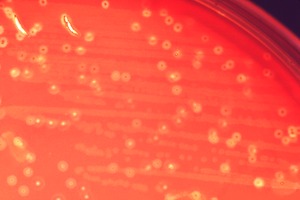Streptococcus anginosus
| Streptococcus anginosus | ||||||||||||
|---|---|---|---|---|---|---|---|---|---|---|---|---|

Streptococcus anginosus colonies on blood agar |
||||||||||||
| Systematics | ||||||||||||
|
||||||||||||
| Scientific name | ||||||||||||
| Streptococcus anginosus | ||||||||||||
| ( Andrewes & Horder 1906) Smith & Sherman 1938 |
| Classification according to ICD-10-GM | |
|---|---|
| B95.48 | Other specified streptococci as a cause of diseases classified in other chapters |
| ICD-10 online (GM version 2020) | |
Streptococcus anginosus is a type of bacteria from the genus Streptococcus ( Germanized : Streptococci). As part of the human bacterial flora, it particularly colonizes the human mouth. Under certain conditions it can act as a disease trigger.
features
Streptococcus anginosus are coccoid (roundish), gram-positive and aerotolerant bacteria that grow in chains. In culture, they form dry, rough and crumbly or smooth and soft, white or gray colonies with a diameter of 1 to 2 millimeters. A production of polysaccharide capsules has so far only been described in one biovar .
Spread and pathogenicity
Streptococcus anginosus is part of the normal flora of humans. It mainly colonizes the oral cavity, where it is most common, and the upper parts of the respiratory organs, but it is also found in the digestive and urogenital tracts .
Streptococcus anginosus can cause diseases , mainly purulent inflammation of the urogenital and digestive tracts, but also of the skin, bones and head. In immunodeficient people, the bacteria can also reach other tissues and organs via the bloodstream and cause diseases there, for example in the central nervous system , in the abdomen or in the blood itself.
Any necessary antimicrobial therapy for infections with Streptococcus anginosus, S. intermedius and the S. constellatus group is carried out with antibiotics. Penicillin , ceftriaxone , cefotaxime , clindamycin and vancomycin are suitable for this .
Systematics
Streptococcus anginosus is the eponymous species of the so-called anginosus group within the streptococci , which also includes Streptococcus constellatus and Streptococcus intermedius . The group is considered difficult and contradictory in terms of taxonomy and nomenclature, but recent results support the division into three types. The group is sometimes referred to as the Milleri group after the no longer recognized species “ Streptococcus milleri ” , the isolates of which were identified as S. anginosus (or in one case S. intermedius ) through genetic testing .
There are two groups of genetic similarities within the species. The majority of the Lancefield Group C β-hemolytic strains form one of the two groups. However, since they cannot be clearly determined biochemically, this distinction has no taxonomic relevance.
literature
- Jeremy M. Hardie, Robert A. Whiley: The Genus Streptococcus - Oral (Chapter 1.2.2) . In: Martin Dworkin, Stanley Falkow, Eugene Rosenberg, Karl-Heinz Schleifer, Erko Stackebrandt (eds.): The Prokaryotes. A Handbook on the Biology of Bacteria, Volume 4: Bacteria: Firmicutes, Cyanobacteria . 3. Edition. Springer-Verlag, New York 2006, ISBN 978-0-387-25494-4 , pp. 76-107 , doi : 10.1007 / 0-387-30744-3_2 .
Individual evidence
- ↑ icdscout.de accessed in 2020
- ^ Marianne Abele-Horn: Antimicrobial Therapy. Decision support for the treatment and prophylaxis of infectious diseases. With the collaboration of Werner Heinz, Hartwig Klinker, Johann Schurz and August Stich, 2nd, revised and expanded edition. Peter Wiehl, Marburg 2009, ISBN 978-3-927219-14-4 , p. 267.
- ↑ Robert A. Whiley: emended descriptions and Recognition of Streptococcus constellatus, Streptococcus intermedius, and Streptococcus anginosus as distinct species . In: International Journal of Systematic Bacteriology . tape 41 , no. 1 , 1991, p. 1–5 (English, sgmjournals.org [PDF]).